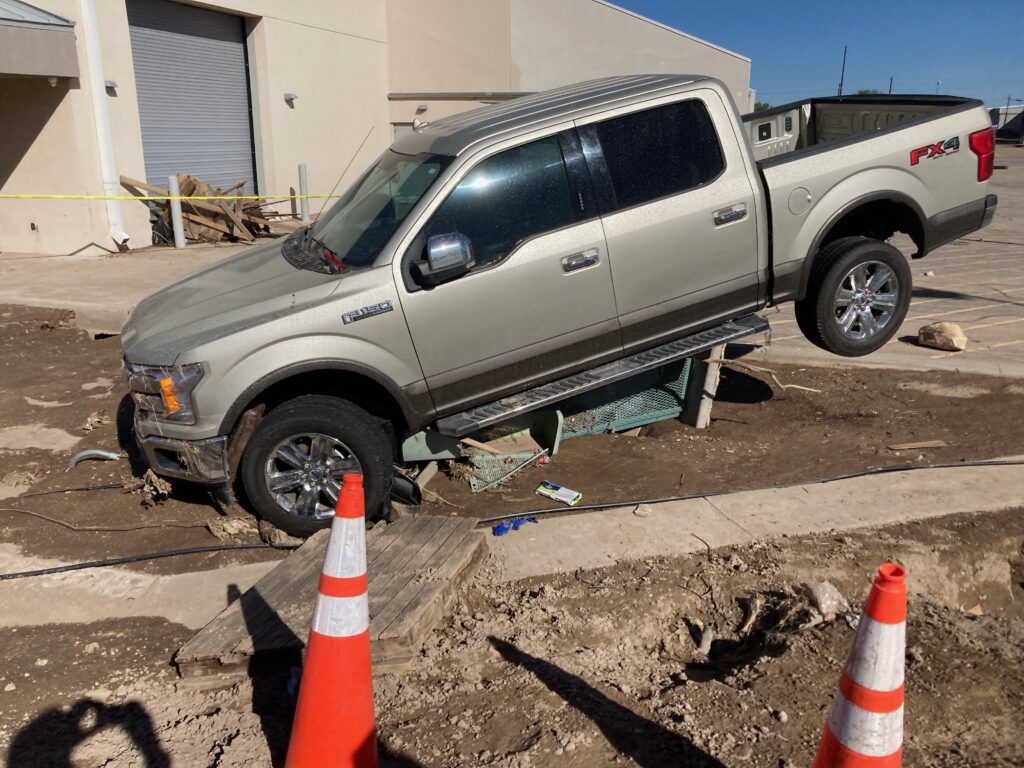A truck carried away in the aftermath of historic flooding in Roswell New Mexico. More than 300 people needed rescues over the weekend. (Courtesy of Zachary Lujan)
New Mexico and federal officials continued to survey damage in Chaves County on Monday after deadly flash floods ripped through Roswell over the weekend, washing away cars, submerging buildings and leaving much of the city under a layer of silt.
State police blame the flooding for two deaths, though officials have not yet released their names or further details.
First responders performed more than 300 water rescues between Saturday and Sunday, according to state emergency management officials. In one instance, over 100 people had to shelter on the rooftops of the Roswell Convention and Civic Center overnight Saturday, after water poured in during a quinceañera, high enough to submerge chairs and tables.
The deluge dumped almost 6 inches of rain, a record for a single weather event in Roswell, according to the National Weather Service.
The city and county are just in the beginning states of tallying the destruction, Roswell Mayor Tim Jennings said in an interview with Source NM.
“The damage is unbelievable,” Jennings said. He said the two flood control dams to the west, did their jobs and caught flooding from the river. It was the rainfall in town that caused the damages. Floodwaters were recorded as five to six feet high in much of downtown.
Jennings said he’s working with state officials to assess bridge conditions, saying he has concerns about “eight to ten of them,” describing rivers crossing over them. High water continued to pose challenges Monday in determining the extent of the damages.
Silt covers the floor and marks the walls in the Roswell Convention and Civic Center. The flooding was as high as five and a half feet inside the building, city officials said. (Courtesy of Zachary Lujan)
The floods destroyed a 42-inch water main and damaged sewer systems, Roswell City Manager Chad Cole said, but water remained potable. Roswell’s airport was also closed after floods swept through it.
Democratic Gov. Michelle Lujan Grisham declared a state of emergency Monday for Chaves County, and was on-site meeting with local officials and members of the Federal Emergency Management Agency Monday. The emergency declaration opens up $1 million in state money for local officials to access for costs during the assessments.
New Mexico is one of many states experiencing more frequent and severe disasters stemming from climate change, said Michael Coleman, a spokesperson for the governor’s office.
“The more of these events we experience as a state, and as a nation, the more our collective resources for responding will be stretched thin,” Coleman said. “We must fortify our infrastructure and make it more resilient against damaging and sometimes catastrophic weather events.”
The state is anticipating meeting the threshold for damages to receive federal assistance, he said.
“It’s unclear exactly when an official federal disaster determination will be announced, but the governor is grateful that FEMA is already on the ground assessing the damage,” Coleman wrote in an email.
Danielle Silva, a spokesperson for the Department of Homeland Security and Emergency Management, said the agency was planning to start the damages assessment Tuesday morning. Search and rescue operations were still ongoing Monday, she said.
Democratic Rep. Teresa Leger Fernández, whose district includes Roswell, plans to visit the city Tuesday, she told Source NM in an interview.
“I want to ensure all the damage throughout Chaves County is documented,” she said.
How did these floods develop?
Meteorologists said a series of storm systems built up Saturday, dumping nearly 6inches of rain north of town, some of it falling potentially as fast as 4 inches an hour, said Andrew Mangham, the senior hydrologist at the National Weather Service Albuquerque office.
“Not only was this a lot of rain, but these were incredibly intense rainfall rates and that is also part of what drives this flooding,” he said. “No storm sewer systems can handle that kind of rainfall rate.”
That 5.78 inches broke Roswell’s previous record of the most amount of rain in a single weather event, according to the Weather Service. The previous record was 5.65 inches in 1901.
“We’re seeing half the annual rainfall get delivered in a single storm, this is absolutely the fingerprint of climate change,” Mangham said.

